From atop a hill, the view of the dry wind-swept plains below is obscured by what at first looks like a dust storm. Soon, it becomes clear that the dust that has engulfed the plain is not from a storm. Here, in what would be known today as Argentina, an epic battle between two of the largest animals that have ever walked the earth is about to reach its conclusion.

Despite the cacophony of deafening sounds coming from the animals in the center of the dust cloud, a loud cracking sound, followed by a blood curdling cry is heard piercing the thick dusty air. The battle is over. As the dust starts to settle, a huge form emerges from it, a sauropod. It moves away at a hurried pace heading towards the open plain.
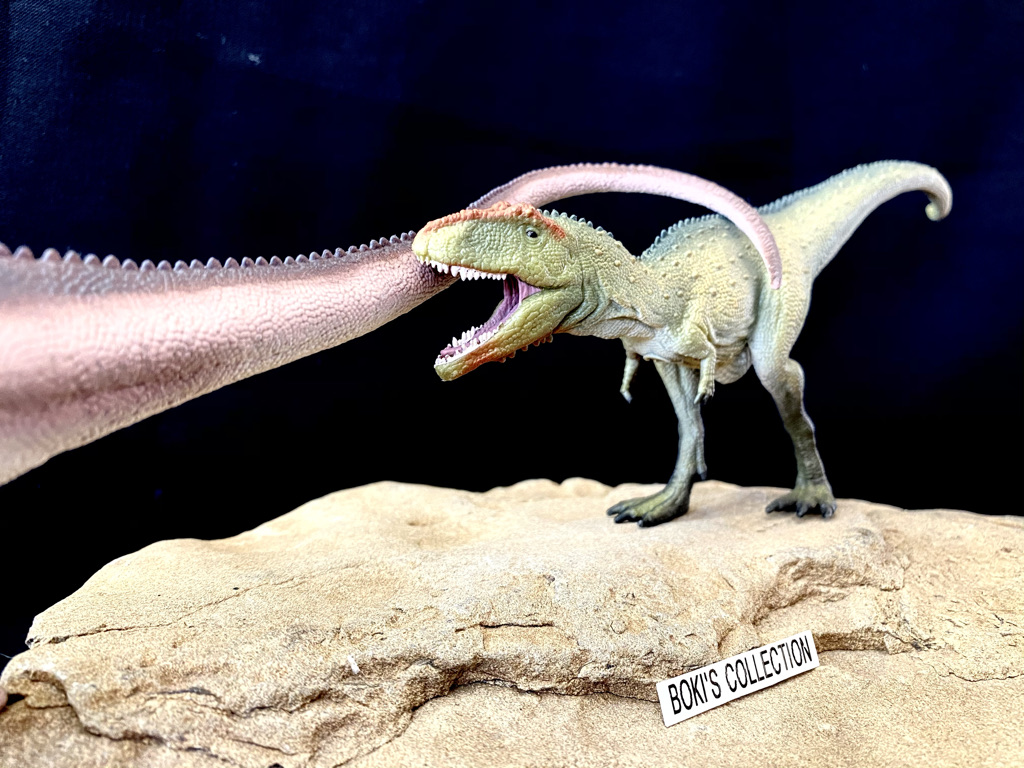
Behind it, another large animal is seen on the ground barely moving and clearly in pain. It is a young Mapusaurus (Earth lizard) temporarily stunned after receiving a direct hit on its side from the sauropods massive and powerful tail.The animal soon recovers, perhaps learning a lesson, it slowly walks away in the opposite direction.
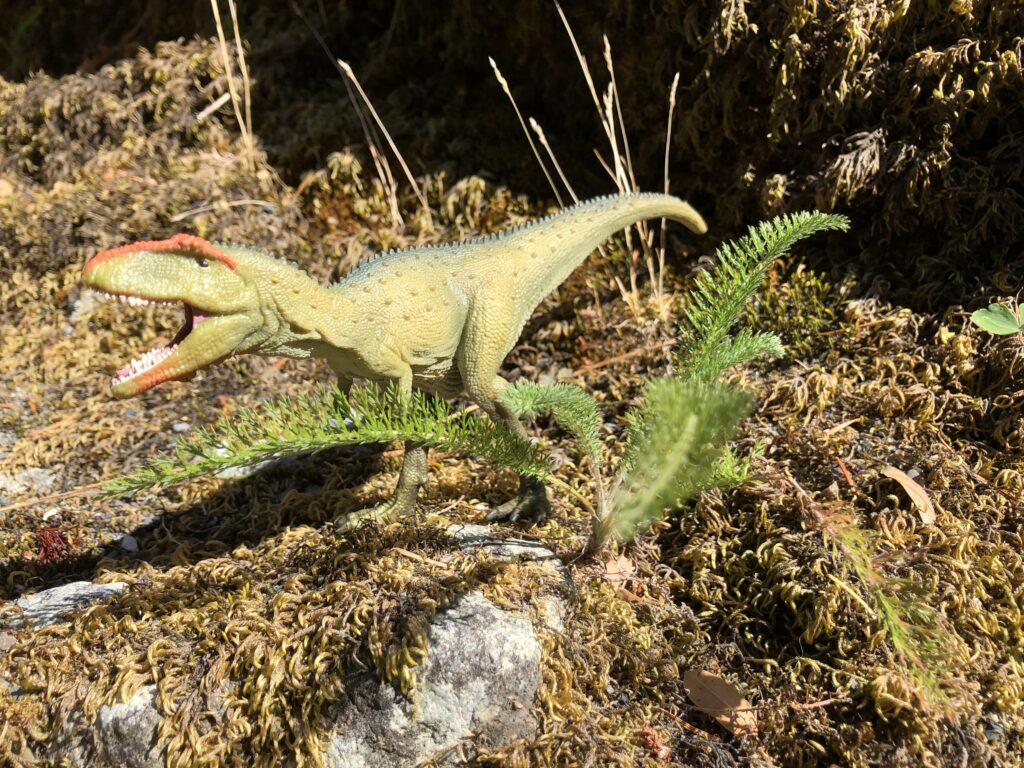
Mapusaurus ( Mapusaurus roseae) was a huge predator from the Late Cretaceous of what is now Argentina. He is a member of the Charcharodontosauridae family of giant super carnivore that once ruled in many parts of world.But despite its huge size, fearsome reputation, and catchy name, Mapusaurus is still relatively obscure when compared to others in the family such as Acrocanthosaurus, Charcharodontosaurus, and the rising start Giganotosaurus.It is also rather rare in toy form, which is puzzling given that it checked all of the boxes for requirement to be considered as the next big thing.
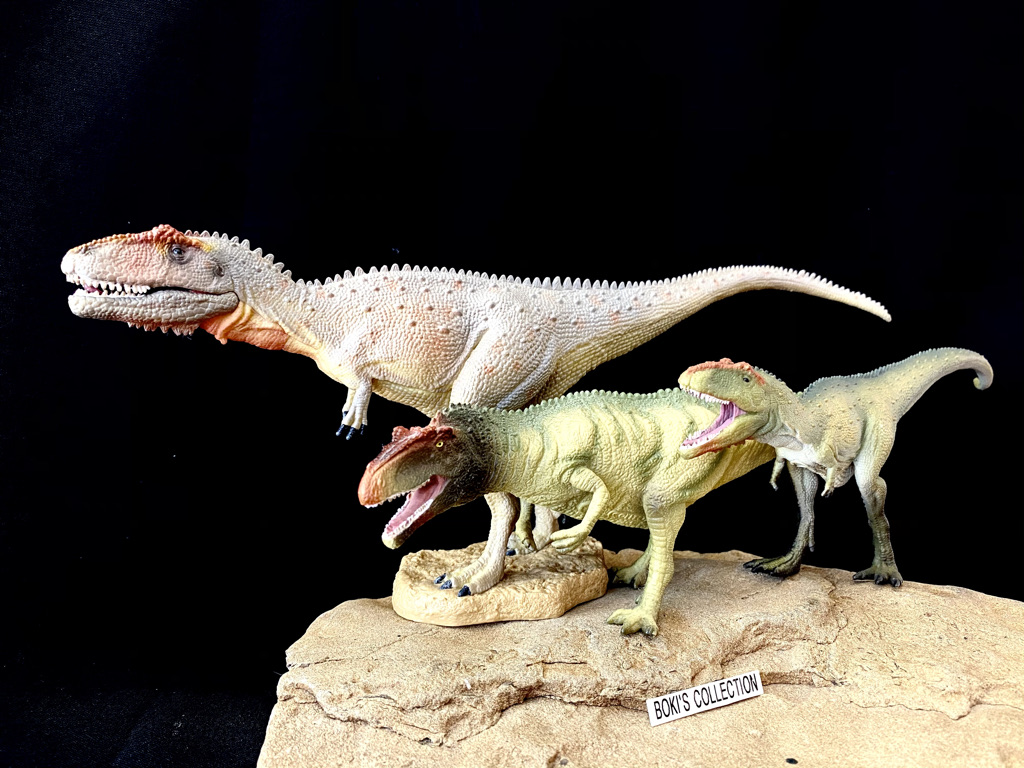
In true CollectA fashion, they surely gave this giant some much needed attention and exposure, releasing not just one, but three figures! CollectA’s penchant for the obscure also gives us a nice record of how a particular species evolve in the subsequent years in how one company chose to portray it.
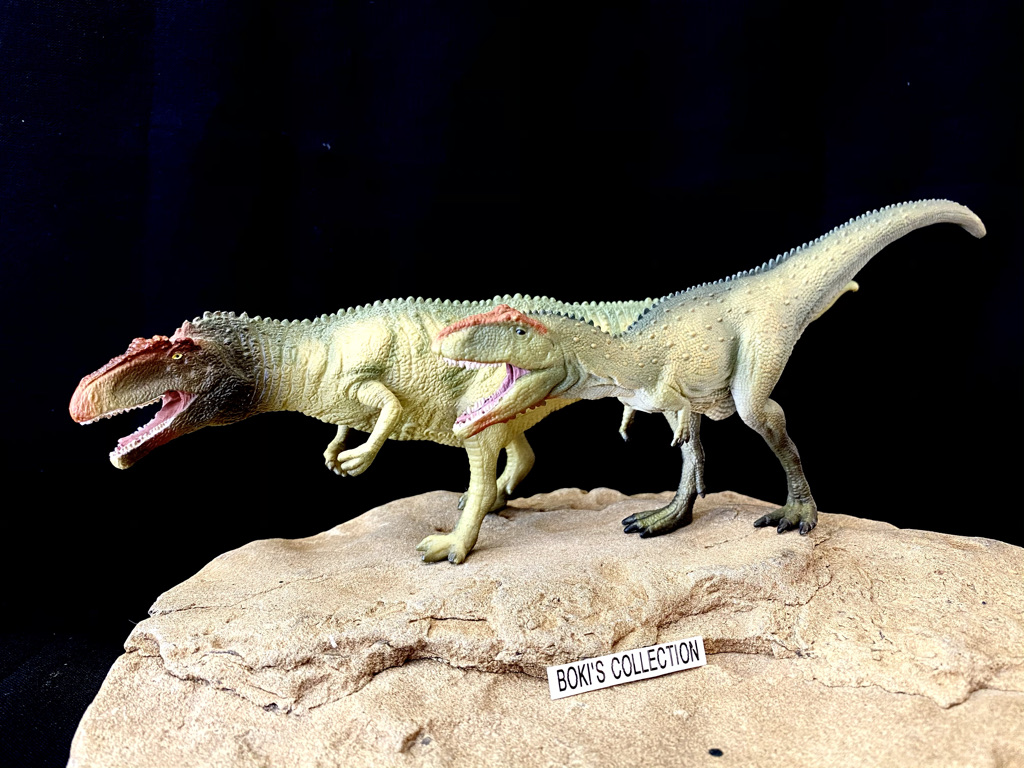
The first Mapusaurus from CollectA was released way back in 2012, right smack in the middle of its transition in sculpting quality.This is perhaps the first toy figure of the species from any major brand and it’s a nice model despite its flaws and having had the unfortunate luck of being caught in a storm and controversy and backlash following its revision from the prototype to final mass-produced product. The whole controversy overshadowed the good thing about this figure, and it would go on as being one of the neglected figures for years.
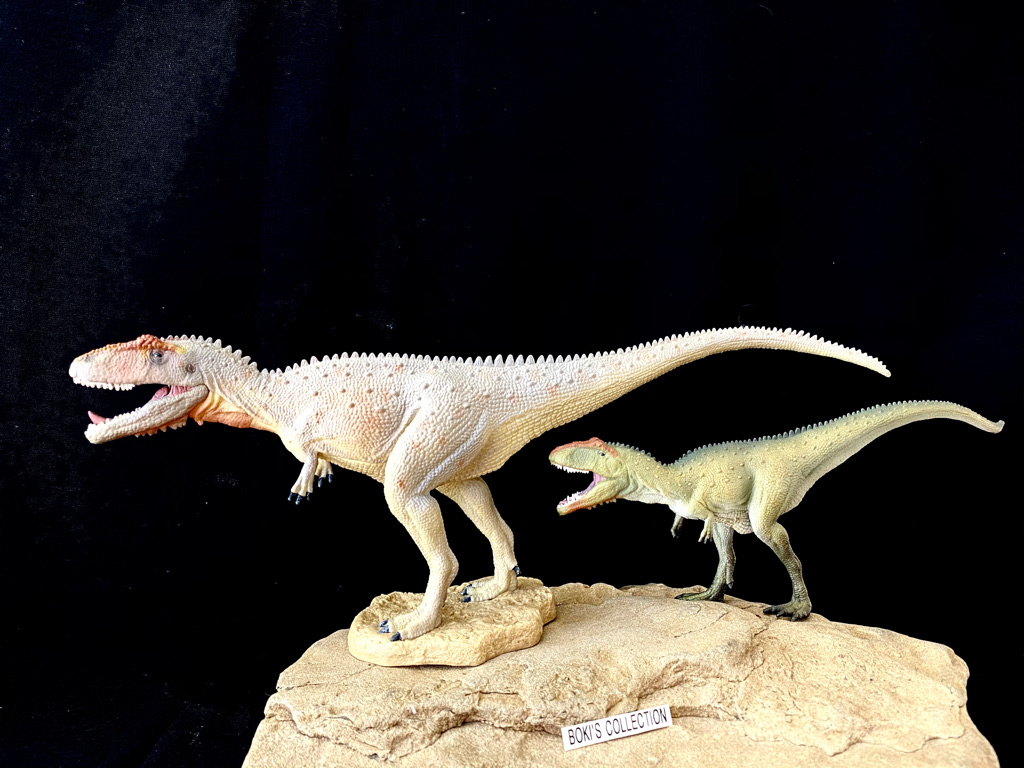
CollectA has not abandoned this species however. Six years later in 2018 CollectA again revisited this species and released a brand-new version in their deluxe range. This time, perhaps learning from past mistakes and with a new artist (I assume), this new figure was true to its promo photos. It was very different from its predecessor, and ranks as one of my favorite large predatory theropod figures. This new figure is sleek and does not have the awkwardness seen it its predecessor.

And just to emphasize just how much they want to make this species as famous as possible, CollectA again released a scaled-down version this year (2 years after the second version), which is what we are reviewing.
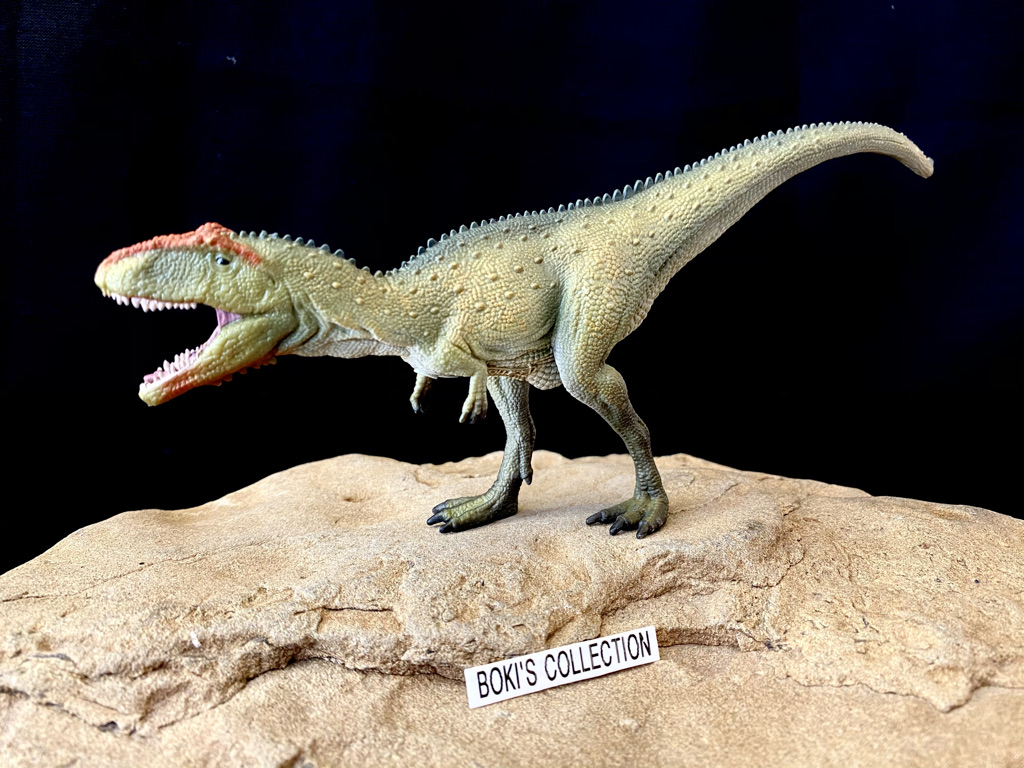
This new version is much smaller that both its predecessors, measuring 9″ inches long and 2.5″ inches tall and is part of CollectA’s standard range of figures. I’m still not sure what criteria CollectA uses in determining which species get both the deluxe and standard treatment, there seems to be no easily decipherable pattern as far as I can tell.As a standard figure, it does not come with a base unlike the 2018 version.

Unlike the Baryonyx and Deinochirus, both which got an almost identical deluxe and standard versions, this one looks very different from the larger version.Officially labeled as hunting (like the smaller tyrannosaurus rex), this figure is given a pretty active pose as if they animal is roaring or about to bite on a prey. The lack of jaw articulation means that it is eternally caught with its mouth wide open.
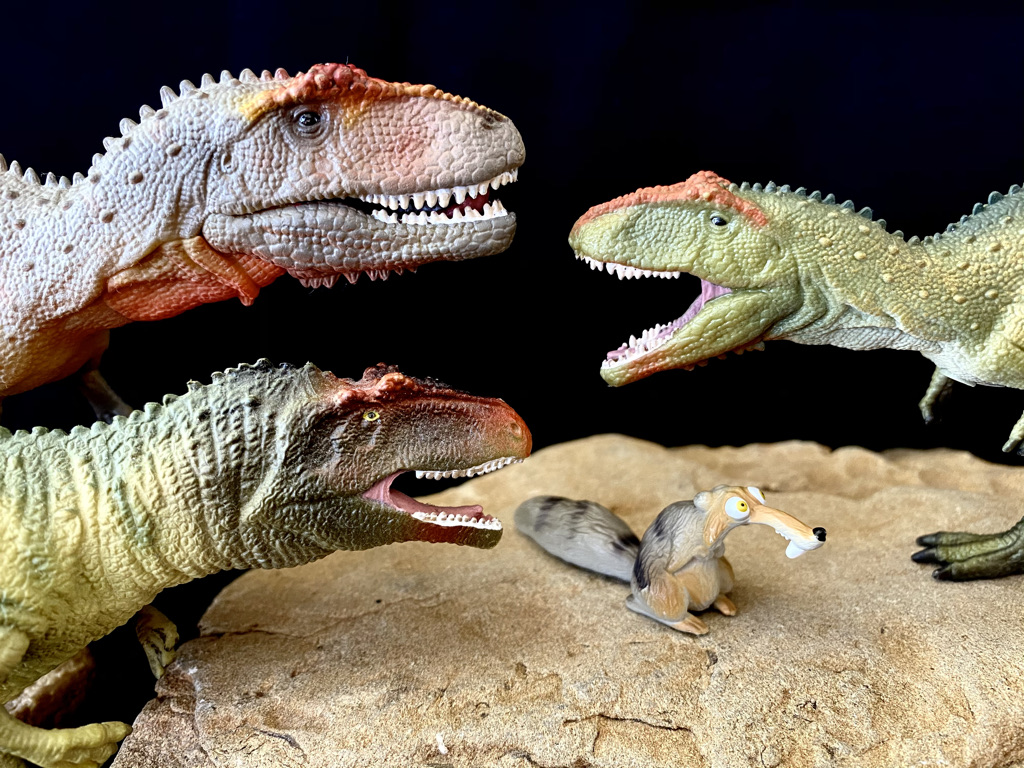
The head is nice but not as detailed as its two predecessors which is a shame since it does have potential. The shape of the head is more rounded than the very first version and is more in line with the newer deluxe one. Although not as detailed, it does have some nice delicate ones that are easily overlooked unless you look closely. Like in its predecessors, the ridge is also colored a hue of red that starts on the snout and runs the entire length of it, in addition, this red color is also seen on the upper and lower snout are where it brings a nice splash of color.
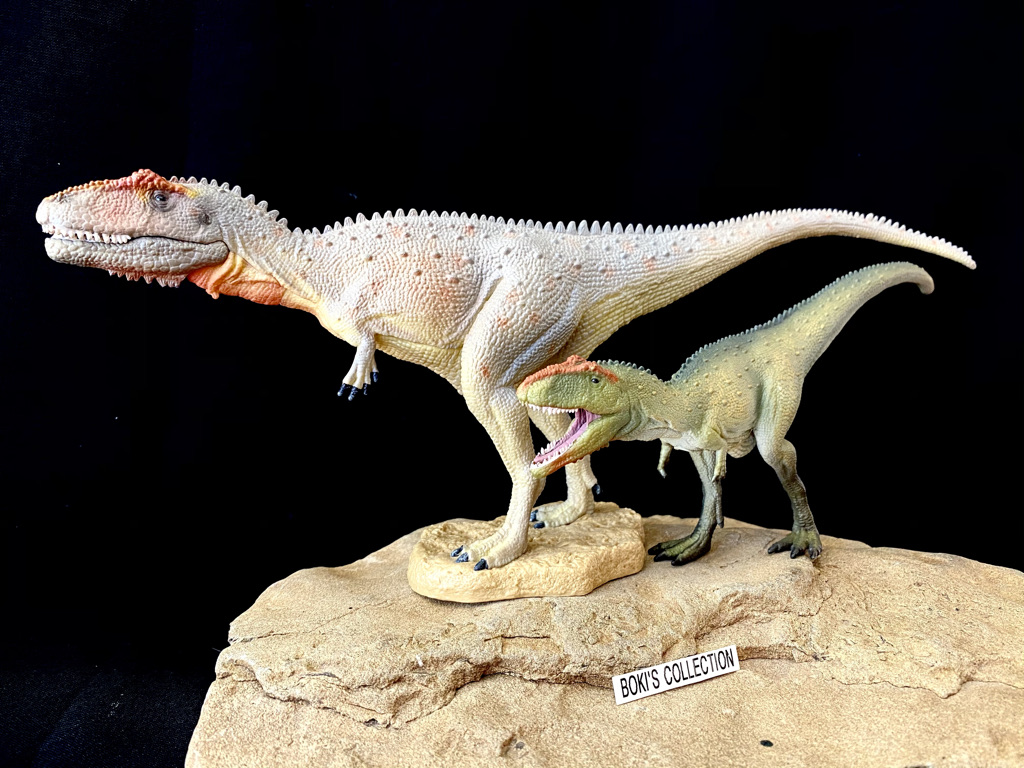
The overall body color is green, which harken back to the original colors of the very first version and different from the brown colors seen on the 2018 version. Unlike the other first two versions, the colors on this figure seems rather subdued and simple in comparison. We don’t see any dark bands as in the 2012, or the rich tapestry of various shades of brown and orange seen on the 2018. Instead, the dominant light green colors ( not as lime green as in promo pictures) are highlighted here and there by a lighter yellow-green shade that adds a little bit of dimension. Still, there is enough variations in shadings and tones to make it not look so flat, especially around the ankles, feet, and hands where you see a much darker shade of green.
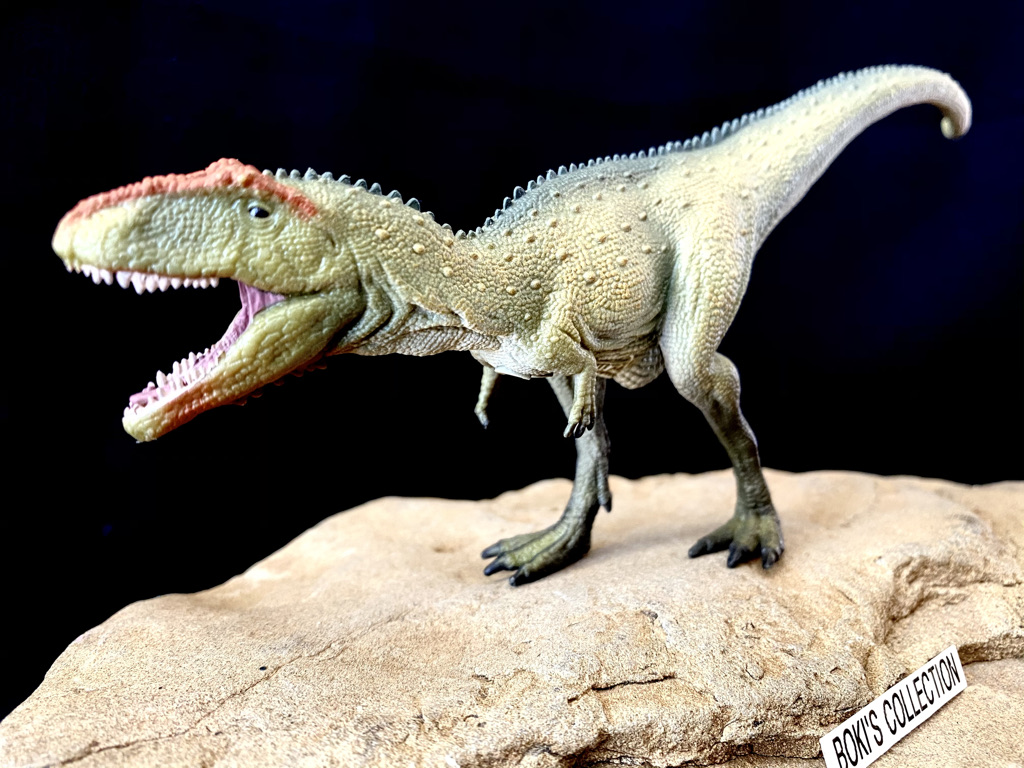
The eyes are small and painted black. The teeth are individually sculpted and are surprisingly sharp and nicely detailed considering the small size, they are also cleanly painted white with very little bleeding, at least on my figure. The inside of the mouth is painted pinkish red and you can see its tongue if you look inside.
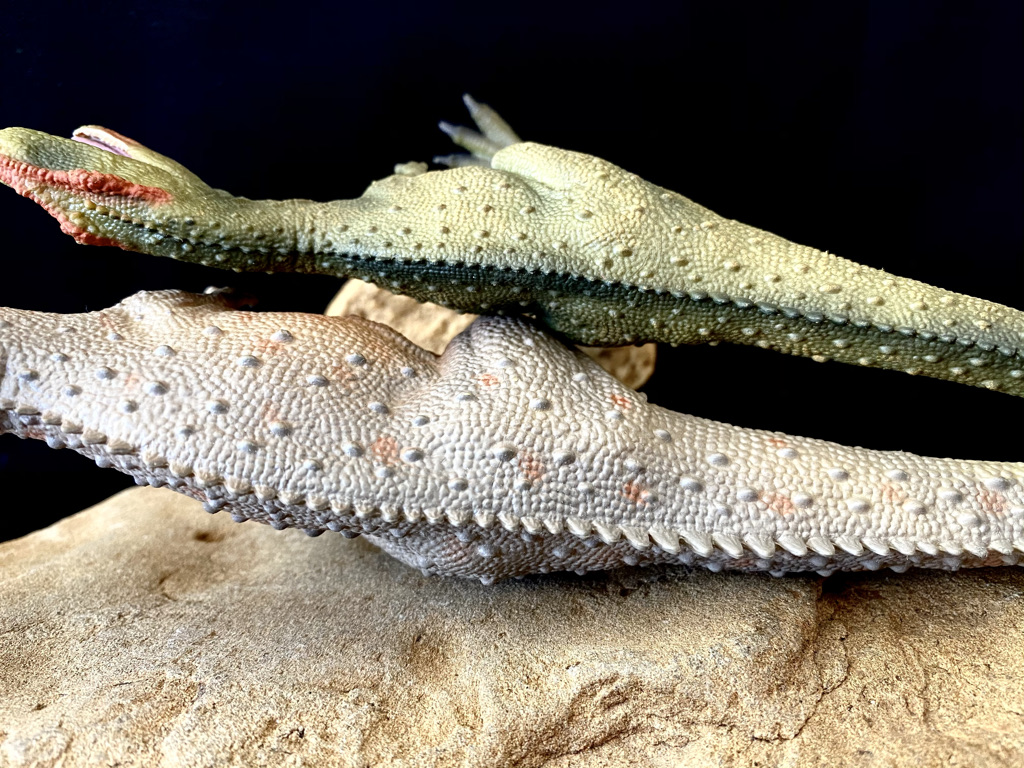
Like its two predecessors, this one is also covered in osteoderms all over its body. In addition, you can see small delicate scales and skin wrinkles and lines. these wrinkles are more concentrated where you would expect to see them such as between the arms and legs areas. There are also some loose hanging folds of skin, a wattle-like, on the throat as also seen on the 2018 deluxe figure.
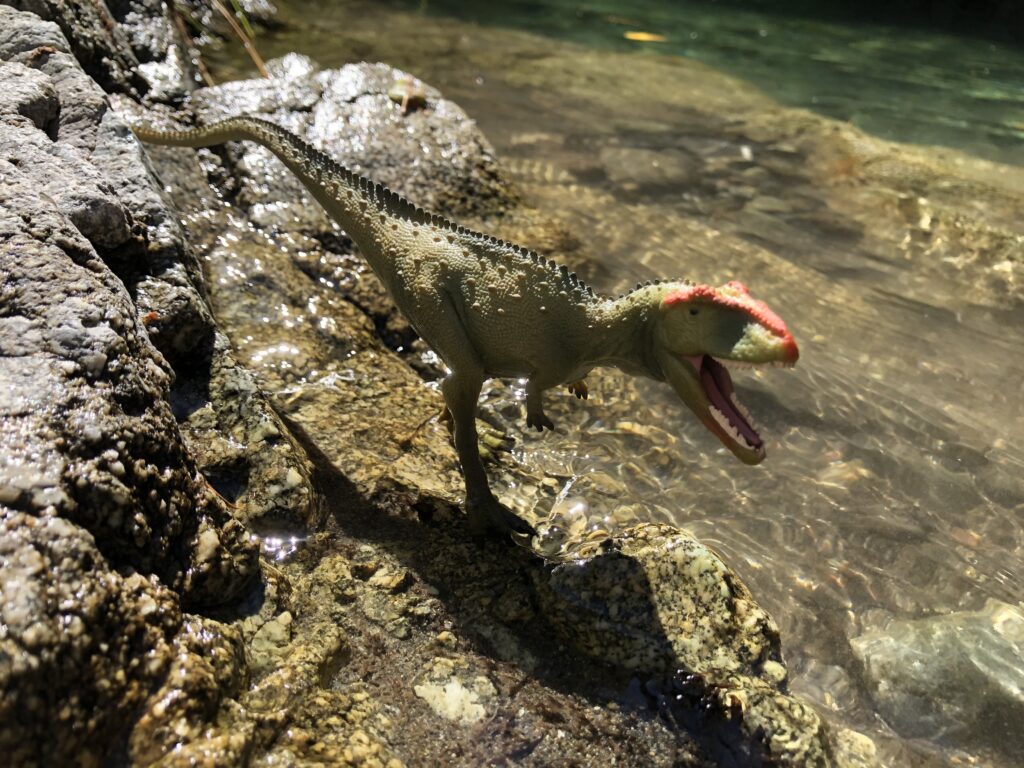
There is also a nice skin folds on the side of the head where the edge of the open mouth creates lines. On the belly and underside, the scales are larger and more pronounced than what is seen on the upper part of the body.There is also a row of dorsal spines that run the entire length of the body starting from the back of the neck all the way down the tail.
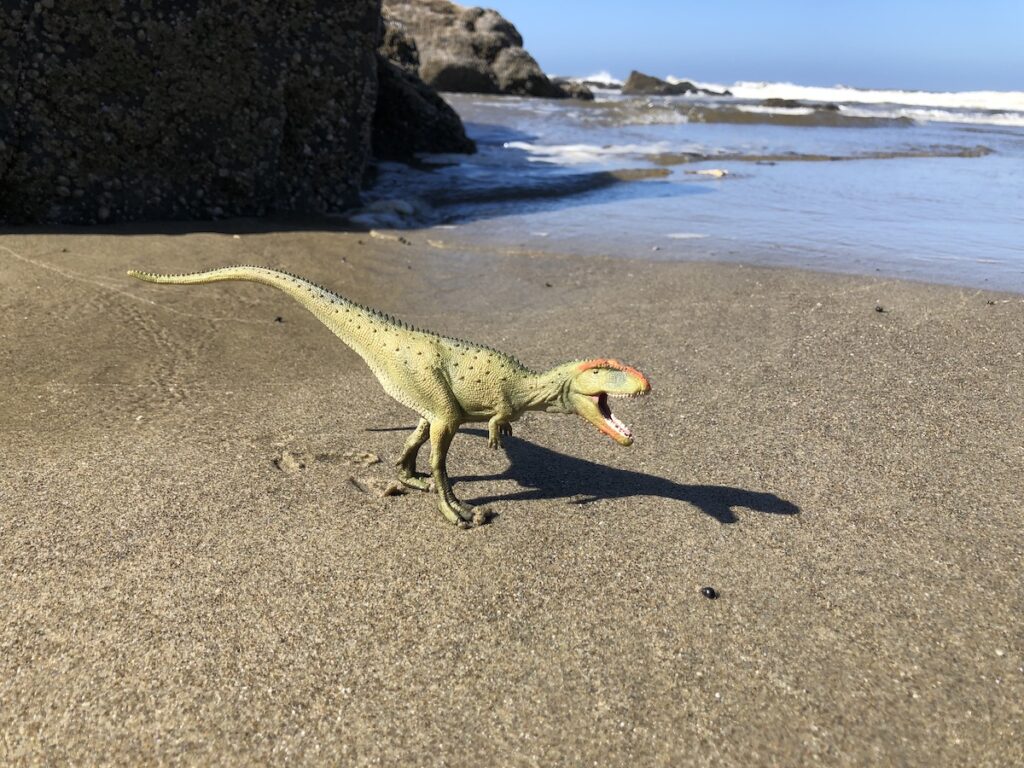
The body proportion is okay, although it could use a little bit more of bulk to it especially in the torso region. To me, this individual looks more like a younger animal than an adult in terms of body proportion. There is that awkwardness in some proportion, like a teenager, something we also see in the feathered standard size hunting tyrannosaurus. So, for me and although not official, I like to think of this as a sub-adult and treat it as such, which nicely fill in that transitional gap.
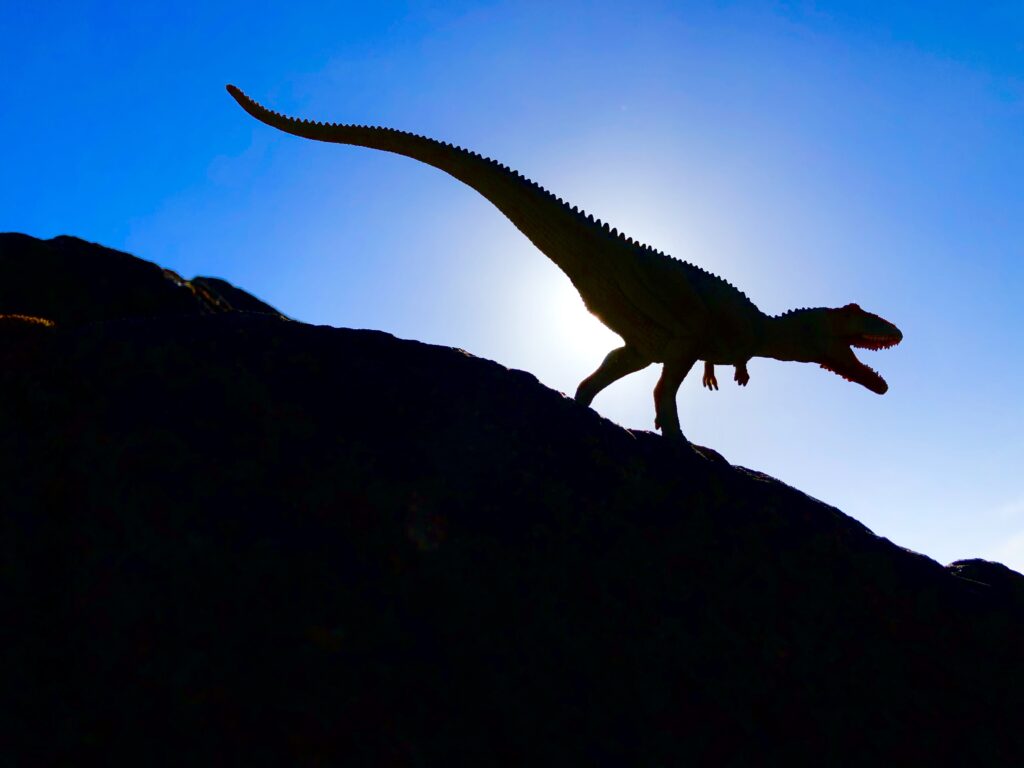
The legs look longer due to the body not being as beefed up, and it didn’t help that the darker outline on the leg made it look even thinner than it actually is, you can see the original outline which looks much better. I think with a proper paint blending, this shadow line could be obscured and make the legs and muscles look more proportioned.The arms are in the correct position and looks more proportioned.

The tail is long and muscular especially at the base and tapers off into whip-like point and curves slightly upwards giving an agitated look.The feet are slightly oversized due to the figure not being attached to a base. Feet size and stability has always been a challenge in terms of how to balance the two. In this case, the figure manages to be able to stand perfectly balanced and stable without resorting to way too big feet or the legs being splayed too far apart. The roaring pose with the head lowered and the tail lifted higher up managed to balance it very well on its feet.
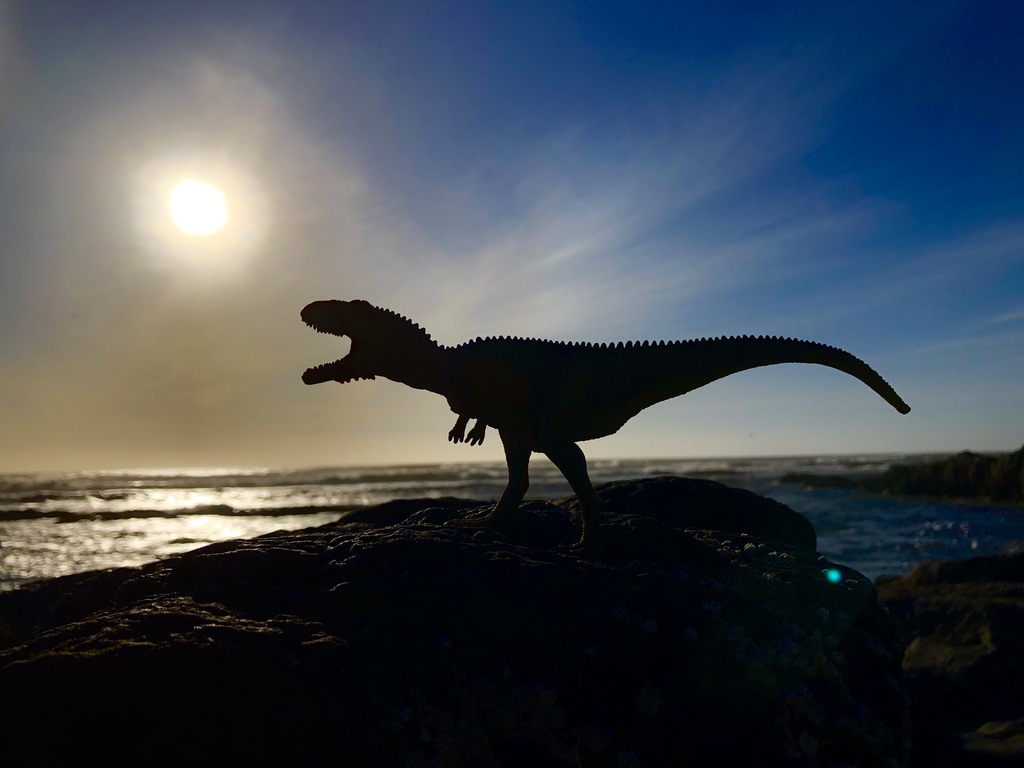
Mapusaurus shared the landscape with some spectacular animal and even perhaps may have hunted the gigantic sauropod Argentinosaurus. It is possible that, based on some fossil evidence of multiple bones of different sized animals all found together, that Mapusaurus hunted in groups. If that is indeed the case, a pack of mixed-aged Mapusaurus potentially go after some of the biggest herbivores in its environment. Speaking of, the smaller size and body proportion of this figure could very well be a younger companion to the 2018 deluxe version.
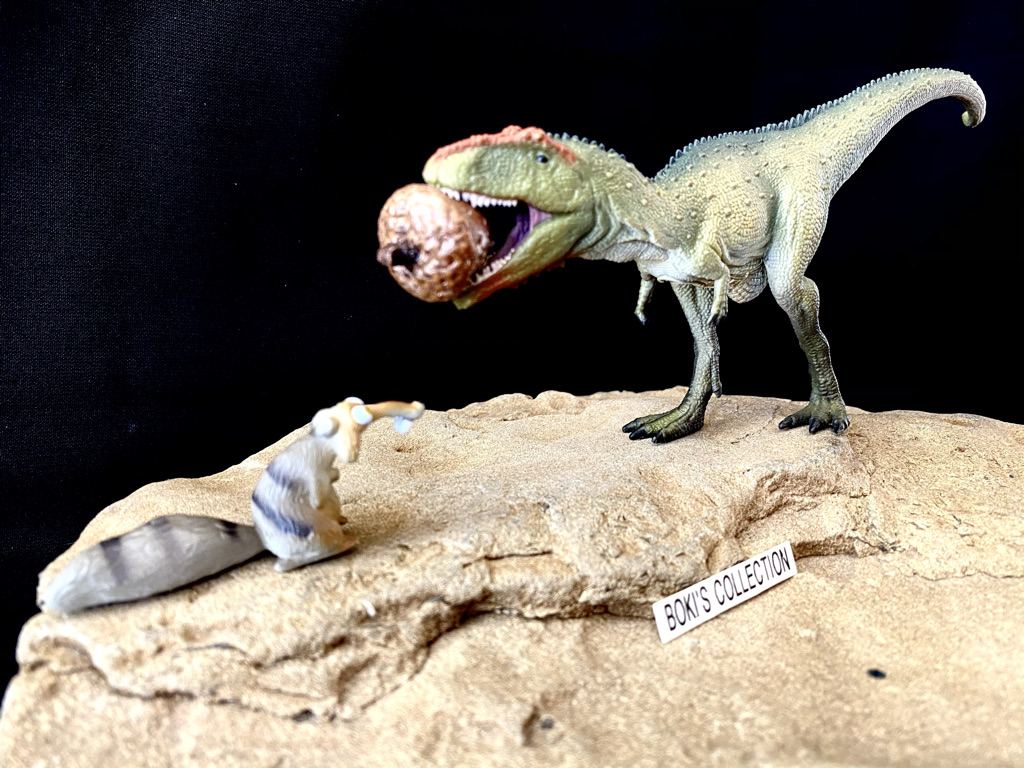
The standard size Mapusaurus is a good alternative if you don’t want large figures. Despite some shortcomings, this is still a good figure in my opinion.It also helps shine a much-deserved spotlight on this often-overlooked southern giant. Hopefully, other brands will give this giant some attention. Thanks for reading, hope you enjoyed it. Until next time, please stay safe and healthy. Cheers!
Disclaimer: links to Ebay and Amazon on the DinoToyBlog are affiliate links, so we make a small commission if you use them. Thanks for supporting us!




It’s honestly an improvement over its standard-size 2012 predecessor. However, there is still no mapusaurus figure that represents me as a collector that I am. I hope that Collecta or another brand of dinosaurs will make more versions of this elusive theropod that are more detailed and precise and that they will be more convincing from an artistic point of view even if it was not scientifically precise.
Great Review, i was wondering when this Figure will get one. I agree on the sub Adult, like with the T. rex. This Review made me order it now, since i was unsure about it.
Great review! This is my favourite of CollectA’s three.
This Mapusaurus could be a good addition as a sub-adult. There are a few errors in the article grammatically (such as spelling CollectA with two semicolons), but those can be excused in which English isn’t your first language or you made an accidental error. I will try to get the 2018 Mapusaurus first (which I believe is the best Mapusaurus out there) then this smaller one. I would call them Rosa (the 2018 figure) and Ross (the 2020 figure) (referring to the species name. Also, the former is the Spanish version of Rose, and references how the remains of this dinosaur were found in Argentina, where the native language is Spanish), and use them as a mother and son. Also, I believe Mapusaurus is not as well recognized as its relatives because it was described relatively recently, in 2006, only four years from now. I will pick this up in the future, though get the 2018 figure first, since it’s on my priority list, and nice review, Bokisaurus.